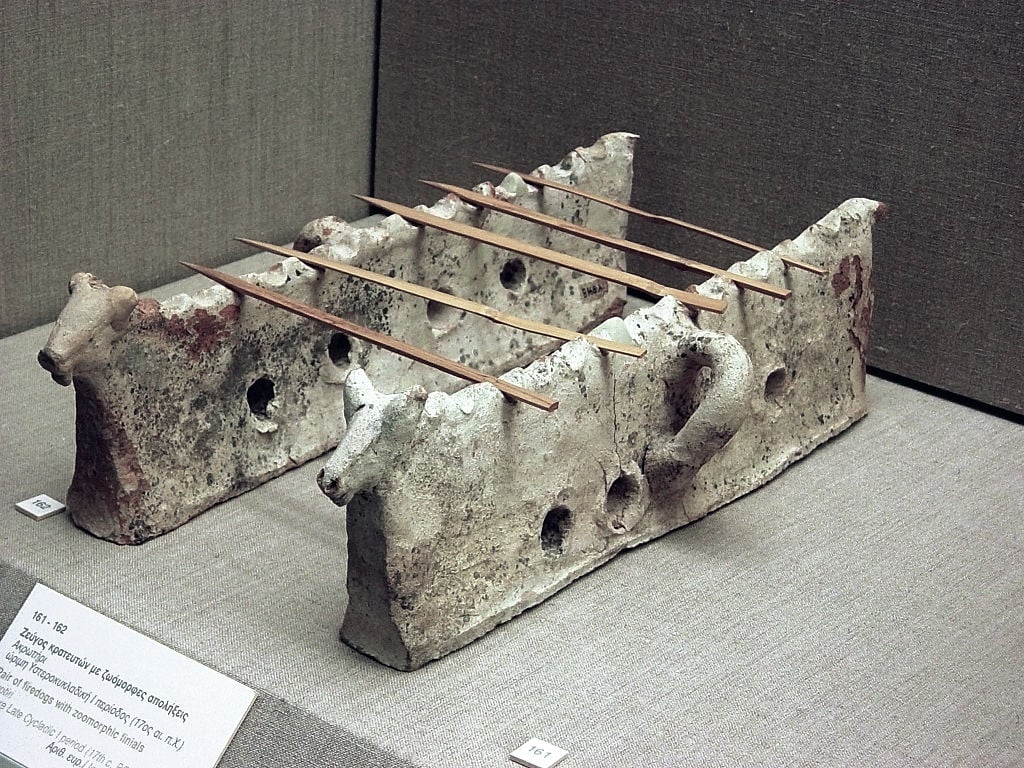

Fast food is not just a modern convenience. In 2023 archaeologists discovered an ancient Minoan street food stall in Akrotiri on Thera island (widely known as Santorini) that dates back 3,600 years, long before Ancient Greece’s classical period.
The fascinating aspect of the discovery of the Minoan fast food stall was that it had painted menus displaying the foods offered. They called this type of stall a “thermopolion” (θερμοπωλείον in Greek), literally meaning “a shop selling warm (food),” where one could go and order warm fast food.
Akrotiri is the name of the village in modern-day Santorini. The settlement dates back to 5000 BCE and was first discovered in excavations that began in 1967.
It was initially a small fisherman settlement, but it became a thriving port city by the 3rd millennium BCE, thanks to its strategic location: right in the middle of the Aegean. It was a hub of a Mediterranean trade route, reaching a population of 30,000 at its peak.
Ancient Thera maintained strong links with the Minoan Kingdom, widely regarded as the first advanced civilization in Europe. The Minoans, based on Crete, were known for their exceptional maritime skills, which facilitated trade and cultural exchange across the Aegean.
The well-preserved archaeological find indicates that the Minoans had an advanced urban culture with conveniences such as street food stalls and social activities. Furthermore, this culture was developed long before the Archaic Period (7th-5th centuries BCE) of Ancient Greece and three millennia before Rome.
The Minoan fast food stalls in Akrotiri probably served souvlaki, too, a dish still popular in Greece today, from fast food stalls to fine dining restaurants. Bronze Age souvlaki skewers and plates dating as far back as 2000 BCE have been discovered by archaeologists in the area.
There are traces of the popularity of souvlaki on Thera and Crete through the Bronze Age, and both Theran and Minoan cultures made use of this method of grilling skewered pieces of meat.
The Therans and the Minoans were known for their luxurious lifestyles, well-made and colorful clothes, and fine art. Importantly, the sea trade with Egypt and other cultures made the islanders a sophisticated society.
The Mycenaeans who conquered the Minoan Crete and Thera in 1400-1420 BCE continued to use the street food stalls with the souvlaki skewers and introduced the portable lightweight souvlaki trays.
After the Minoans and the Mycenaeans, street food appeared in mainland Greece in later years as well. Fast food first emerged in Ancient Greece around the 6th century BCE with the development of cities.
The daily gathering of people at the famous agora of Athena was not only for socializing and philosophizing but also for eating. The smell of grilled meat from street vendors was an unparalleled appetizer.
Ancient Greeks had their street food, an early version of souvlaki, but they called it something different then. The tantalizing skewered meat was called oveliskos (οβελίσκος), meaning meat on a skewer. The meat used was lamb or pork.
In the street stalls, other vendors made flatbread similar to today’s pita bread. Ancient Greeks often put the oveliskos on the pita, which is the culinary ancestor of modern-day souvlaki. Pieces of meat on a skewer, grilled over fire, were a favorite of travelers and visitors as well.
In ancient Greek festivals like the Panathenaea in Athens, the animals sacrificed to the gods were turned into food and the festivities into public feasts. Expert butchers would cut the meat and give it to the Athenians, who had brought bread to accompany it. The meat of the sacrificed animal was considered an offering from the gods. The vendors offered more delicacies such as olives, roasted chestnuts, and sauces for the meat.
Festivals similar to the Panathenaea took place in other, smaller city-states across Ancient Greece.
The vendors at the agora were mostly farmers, and they were not selling ready-made food. They were offering products like koulouri (then called kollyra), a round-shaped bread roll, barley, wheat, fish and other seafood, fruit, nuts, sweets, vinegar, wine, dairy, and meat. Some did sell hot lentil soup, though.
Some archaeologists called Akrotiri the “Minoan Pompeii.” The reason is that similar to street food stalls like the Minoan ones were discovered in Pompeii a few years ago. The Romans called them thermopolium and the stalls were very much alike to those discovered in Thera.

As for the painted menus, the detailed frescoes full of food imagery were the ideal advertisement for the foods they offered. The painted fish, for example, were more of a creative interpretation. The artwork itself is realistic and well-documented.
The exceptionally well-preserved, ornate stall that looks like a food counter decorated with polychrome patterns and frozen by volcanic ash, as Mount Vesuvius erupted and buried Pompeii in ash and pumice in 79 CE.
According to researchers, thermopolia (plural) were very popular in the Roman world and Pompeii alone had around 80.
